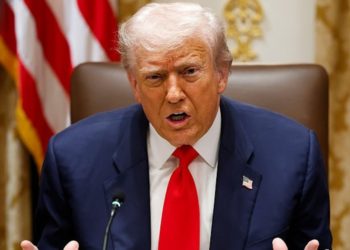At last week’s NATO meeting in The Hague, U.S. President Donald Trump declared that the United States’ European partners had pledged to raise their defense spending to 5 percent of GDP by 2035. Irrespective of whether the leaders of these countries can now marshal the popular and fiscal will to make that commitment a reality, Washington under Trump has forced its NATO partners to step up and at least appear to take a stronger line in defending themselves.
The stakes are arguably even higher for American allies in Asia, because they are much closer to an assertive China. The Trump administration has already clarified that what it demanded of Europe it now expects from its Asian partners. For one ally in particular, Australia, that higher defense ask is ushering in a period of discomfort in relations with Washington. For a long time, Canberra has walked a tightrope strung delicately between a trading relationship with China and a security alliance with the United States. Now, though, the debate over Australia’s strategic options is becoming more urgent and more fraught. Can Australia still have it all—or will it finally be forced to choose between its biggest trading partner and its security guarantor?
Since its election in May 2022, Prime Minister Anthony Albanese’s Labor government has touted its alliance credentials through its fervent commitment to AUKUS, along with further force posture measures aimed at deepening the integration of its armed forces with the United States’. Arguably not since World War II has the American military footprint in Australia been so big; the country has made itself critical to U.S. warfighting capacity in Asia.
At the same time, Canberra has adopted a policy of “stabilization” with China after a rocky period in relations. In return, China has lifted punitive trade restrictions it had placed on key Australian export industries such as lobster, barley, wine, and coal. High-level meetings and exchanges between Australian and Chinese leaders have also resumed. It now looks as if Albanese will meet with Chinese President Xi Jinping before he sits down with Trump.
But Washington now looks to be asking Australia to pick sides. During a major speech at the Shangri-La Dialogue in Singapore in late May, U.S. Defense Secretary Pete Hegseth started to lay out the Trump administration’s geopolitical cards for Asia. His message was blunt: Washington no longer buys the historic hedge. Countries like Australia who balance economic ties with China and defense relationships with the U.S. are apparently a potential drag on decision-making in a time of military crisis. A long-standing American frustration with Australia—that it relies too heavily on China for its economic prosperity—is once more out in the open.
On the sidelines of that gathering, Hegseth also told his Australian counterpart, Defense Minister Richard Marles, that he expects Canberra’s defense spending to reach 3.5 percent of GDP. As if to make sure the message was heard, the Pentagon then initiated a 30-day review of the AUKUS agreement, a move on which interpretations are divided. Either the administration is preparing to back away from transferring two to three Virginia-class submarines to Australia in the early 2030s, as foreshadowed in the agreement, or it will use the review to prod Australia to contribute even more financially to the United States’ submarine industrial base.
Meanwhile, Albanese is sticking to his government’s promise to increase defense spending to just 2.3 percent of GDP by 2032. For the moment, the United States will have to accept that Albanese can’t be kicked around, if for no other reason than they need the American installations and intelligence facilities on Australian soil. Marles’s recent statement that Australia’s geography is now more important than ever to a possible U.S.-China conflict might have been made specifically to divert the attention of Washington away from percentages of GDP and onto the brass tacks of how much Australia’s real estate is worth in any future military contingency with China.
Washington would likely prefer a return to the Australia of only a few years ago, which proclaimed itself to be a model for the rest of the world in standing up to Xi’s China. Canberra’s aggressive stance was not only noticed, but it was also rewarded. In early 2021, Trump’s deputy national security advisor, Matt Pottinger, publicly credited Australia for stiffening Washington’s approach in the crafting of its own strategy for confronting China in Asia. In June that year, then-Australian Prime Minister Scott Morrison attended a G-7 summit in Cornwall where he distributed to leaders a list of demands that the Chinese Embassy in Australia had made about the changes it sought to some of the nation’s democratic institutions and practices. He was, in effect, displaying Australia’s credentials as the frontline state for taking on China. By this time, too, Morrison had already set in train the secret discussions which would result in Australia cancelling a deal with France to build its new class of diesel-powered submarines. But it was at that same summit in Cornwall where he and British prime minister Boris Johnson gained agreement from then-U.S. President Joe Biden that the United States would, for the first time since 1958, share sensitive nuclear technology with a close ally, enabling Australia to eventually acquire a nuclear submarine capability under AUKUS.
Four years later, however, Australian China policy is transformed. Albanese, recently elected to a second term in office with a vastly increased majority in the Australian parliament, regularly points to the success of stabilizing relations with Beijing. And almost every time he mentions China, Albanese stresses that it is Australia’s largest trading partner. At its core, stabilization indicates a certain civility and common sense between the two countries. Albanese, alongside Foreign Minister Penny Wong and Trade Minister Don Farrell, have put down the megaphone of their predecessors and stated, almost in unison, that Australia will “cooperate [with China] where we can, disagree where we must, and engage in the national interest.” The phrase is an adaptation of the language the Biden administration used on China when it first came to office, but the Australian government has adopted it as its own.
Consequently, when Chinese Premier Li Qiang visited Australia in June last year, the joint leaders’ statement was a blizzard of new memoranda of understandings (MoU), along with continued or expanded joint dialogues on trade, climate change, energy and the environment, and border enforcement, among others. An MoU on defense and maritime affairs will result in the two countries agreeing to improve military communication following dangerous incidents in the East China and Yellow seas in recent years. These MoUs may represent the new barometer for movement in the relationship, but they are merely diplomatic cladding around the two countries’ ongoing economic complementarity. Even during the period when ties sunk to their lowest political ebb, from 2017 to 2023, Canberra’s exports to China nearly doubled from AUD$116 billion to AUD$219 billion.
Washington’s call for a higher defense spend is not the only new pressure on stabilization. In Singapore, Hegseth also appeared to imply that Asian allies’ outward trade should be limited with China. That’s as much a red line for Australia as it is for other key American allies and partners. If that is the pattern the Trump administration is establishing, Australia will need a rebuttal. The prime minister and his negotiators might point to how the United States took advantage of Chinese restrictions on beef to expand American market share during China’s economic coercion of Australia.
So far, the Australians—like another Indo-Pacific ally, the Japanese—are not budging. In response to Trump’s decision to raise the tariff on Australian steel from 25 percent to 50 percent, Farrell has ruled out retaliation but made clear Australia’s resolve. He emphasized to journalists that “Chinese trade is almost 10 times more valuable to Australia” than Canberra’s trade with the U.S., which in 2023 sat at about $34 billion. And he added that Canberra “doesn’t want to do less business with China, we want to do more business with China.” Just in case his American interlocutors had not heard the message, he then declared, “We’ll make decisions about how we continue to engage with China based on our national interests and not on what the Americans may or may not want.” This is strong language from an ally that still expects America to come to its assistance in a time of military need.
Even the appearance of a group of Chinese naval vessels, and later a Chinese research vessel, off the Australian coastline earlier this year showed that the government was sticking to its stabilization line. Speaking about the presence of the research vessel, Albanese told reporters he “would prefer that it wasn’t there,” but added that “we live in circumstances where, just as Australia has vessels in the South China Sea and vessels in the Taiwan Strait and a range of areas, this vessel is there.” If a Japanese prime minister made a similar comment, it would likely provide grounds for resignation.
Stabilization was never intended as a synonym for detente. But it does appear as if the policy is going to prove difficult to sustain: not only beneath the glare of Washington asking much harder questions of its allies, but with China more prepared to brandish its military reach into Australian waters. Perhaps the greater paradox is between what Australia seeks to achieve at the level of bilateral relations and what is occurring in the wider world.
Calls by Canberra for China to pursue a “stable order” in the region and the world are rendered less effective since Australia assumes it can set the point of where that stability lies: namely, with the preservation of U.S. primacy in Asia. That is clearly unacceptable to China. Only with the perspective of time, then, will it be clear whether stabilization was part of a system of off-ramps to avoid military conflict, or a temporary hiatus in a climate of ongoing strategic febrility and contest.
In its first term, the Albanese government committed to the search for regional “strategic equilibrium” and the emergence of a multilateral Asia, provided the U.S. remained at its center. That was code for Washington maintaining its trade, military, and investment protection and influence among all the East and Southeast Asian allies. But the Trump shocks bring new pressures and problems to this approach and the assumptions driving it. Canberra’s first priority has to be to join with Japan, South Korea, Indonesia, and other members of the Association of Southeast Asian Nations, and to forge with Europe, Canada, and developing nations a path to restore a rules-based trading regime—even if the United States absents itself. And if Trump becomes totally untrustworthy, Australia’s national security establishment will also have to contemplate the possibility that this island continent in the South Pacific may well find itself home alone.
The post Australia Can’t Have Its Geopolitics Both Ways appeared first on Foreign Policy.




